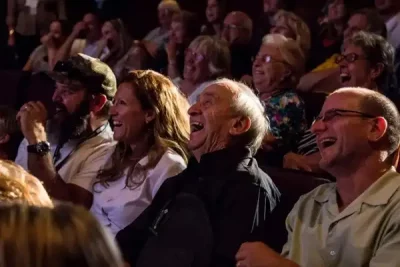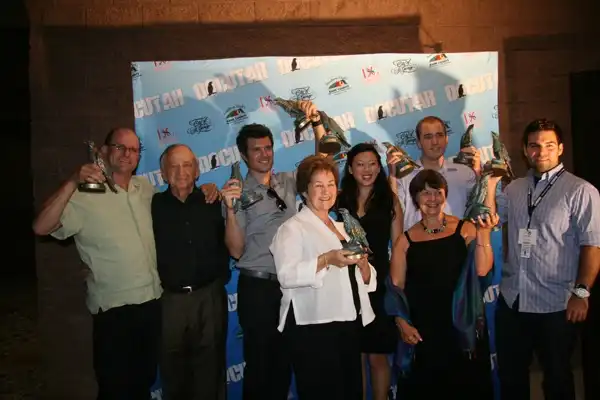Down-To-Earth, Down South at the DocUtah Film Festival 09.05-09
Film Reviews
St. George is an interesting city. Nestled near the Utah boarder, St. George is a buffer for those entering Utah from Vegas. What a strange trip that could be, right? Just coming down from your Fear and Loathing themed get-away in the city of sin, only to roll into one of the most conservative states in the nation. It’s like raiding the liquor cabinet and then having your grandma help you pick out underwear.
Most of us might need liquor to get through that shopping trip (some people feel they need liquor to get through the state). That’s where St. George comes in. Not their fine liquor stores (and fine stores they are!), but the laid back atmosphere that can be found there. St. George helps people lower their guard as they enter the state, the relaxed atmosphere is inviting, the waitresses are cool, and the entire populace seems to have a warm and welcoming persona.
These are the exact characteristics that I found to be the most appealing about the DocUtah Film Festival. Only in its third year, DocUtah has the down-to-earth feel that I think every festival should have. From the directors of the festival to the filmmakers and audience, I felt like everyone was simply there to enjoy a shared film experience. The festival has continued to grow every year, but the will remain rooted in the community.

There were several filmmakers who had traveled from out of state to show their films here, but the people attending were local, and proud to be hosting. There were many ways in which the community was involved in the festival. All of the films screened were selected by committees of members of the community.
The judges were prominent members of the community and area film buffs, and many of the films that were selected for screening were produced by students in the Dixie Film Program. No one here had a chip on their shoulder.
I’ve covered a number of film festivals for SLUG, and I was able to have the most “real” conversations with the filmmakers at DocUtah. Nothing was exclusive or secret, no one was too good. Aside from the film screenings, my favorite part of this festival was the fact that I got to sit down to enjoy a few beers with several of the filmmakers where I got to answer the usual Utah questions.
“What’s up with the alcohol laws?” “Tell me more about the Mormons.” We closed the joint down. This is what a festival should be: festive, communal, and all inclusive. DocUtah nailed it. Here are a few reviews of the films I was able to see.
Terra Blight
Directed by Isaac Brown
Terra Blight explores the massive consumption and production of electronic goods in the United States with an emphasis on what happens when we get rid of our outdated computers. Cutting between representations of the seemingly senseless drive to continue to get what is newer and better in the U.S., and where all of this stuff ends up, director Isaac Brown shows the disgusting conditions in which our waste is impacting residence in third world countries where outdated computers are shipped as “donations to the less fortunate.”
A small town in Ghana neighbors a toxic, landfill-sized pile of dead, useless technology where kids earn money salvaging metal by breaking it out of monitors containing lead and mercury. The waste has poisoned the land and water, and is responsible for the premature deaths of several youth in the area. A much more stark and harsh view than Annie Lenard’s The Story of Stuff. This is a film that everyone should see.
Brown asks in the film if our use of the technology for gaming and social networking truly justifies the use of natural resources and materials that are not being recycled and could be poisoning other populations. Brown offers solutions that could be effective if implemented properly, but currently, our material-driven lifestyle and the amount of money that can be made from producing a new iPhone every year seems to take priority in our society.
Pad Yatra: A Green Odyssey
Directed by Wendy Lee
In the midst of global climate change, it is still easy to look at how we are directly affected by changes in weather pattern, like the fact that it was extra hot this summer and the snow really sucked last year. In Salt Lake Valley, we can look at the bad air we’re trying to breathe and see a direct correlation between the actions we take and how they are impacting our environment.
I can’t see the mountains through the smog, so it makes sense that we’re killing the ozone. The thing about global climate change is that it is impacting everyone.
Wendy Lee’s film shows us what happens when a small community in the Himalayas is blindsided by unseasonal weather patterns that they can’t explain and don’t understand. Seeing the need for action, 700 people set off on a roughly 200-mile trek through the Himalayas to raise awareness for how their communities are being impacted.
Headed by Drukpa, a Buddhist monk, the travelers teach the locals they encounter about environmental respect and responsibility while doing their best to clean up as they go. During the entire span of the journey, the group collected around 800 pounds of plastic bottles that they were able to ship off to have recycled.
The Drukpa spreads his message of respect for nature and all creatures with those he travels with, often courting animals they encounter to commune and share in life.
The overall message in the film is one of respect and determination. Lee’s crew consisted of herself and a Himalayan monk who worked the camera. Despite their simple set up, they were able to capture the vast landscapes and beauty that they encountered as well as the emotional turmoil and internal revelations that every participant journeyed through.
The Approach
Directed by Adam Ferraro
Written and produced at Dixie College, The Approach takes a close look at the passions we have, and the paths we choose to pursue them. Focusing on rock climbing, Ferraro draws a comparison between weekend warriors, climbers who work a regular job and have to climb weekends and evenings, and “dirtbags”––climbers who live to climb living in their cars and working seasonal jobs to ensure that they can spend as much time climbing as they can.
Filmed primarily around Southern Utah, the rich colorful rock landscape and mountainous backgrounds are captured as we get to see climbers scaling a wide range of terrifying terrain. The climbers share the stories of the lengths that they go through, and the hygiene sacrifices they make to dedicate their lives to living and climbing freely.
At times, the line separating the dirtbaggers from weekend warriors seems thin and undefined, but the idea is widely adaptable to any hobby or lifestyle. There are those who will give their life, income and love to something, while others have to have things like families, homes and hobbies on the side.
Andrew Bird: The Fever Year
Directed by Xan Aranda
The Fever Year follows Andrew Bird as he composes his complex, layered melodies in his intimate home, and has he plays through the U.S. on a grueling and intense tour. Much like his music, Bird comes across as brilliant and complex as viewers get a glimpse of his creative process.
This film is beautifully composed in such a way that you easily become lost in it, forgetting that you are watching a film, feeling intimately close to Bird as he talks you through milestones in his career, his ups and downs, and his insecurities and challenges. Old and new footage of Bird performing is intermixed with fluidity to show his transitions and growth in style.
Bird’s fever is his reality, and appropriately symbolic of his unrelenting drive to create. His mind never seems to stop as the lyrics and music appear to come to him with ease. I couldn’t help but wish that I could have been a fly on the wall at any point of the film to hear what he is hearing, if anyone can really hear what he is hearing.
For more info on the festival, go to docutah.com.
